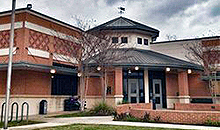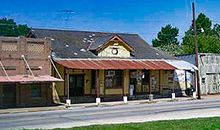Main Menu
Bastrop County Data
Bastrop County Communities & Places
Genealogy & History Links by USGHN
Important Bastrop County Addresses
Sponsors
Bastrop County Neighbors
Caldwell County, Texas Genealogy & History Network
Fayette County, Texas
Gonzales County, Texas Genealogy & History Network
Lee County, Texas
Travis County, Texas
Williamson County, Texas
Other Websites
Welcome to Bastrop County Texas Genealogy & History Network!
Welcome to the Bastrop County, Texas Genealogy & History Network. Our purpose is to provide visitors with free resources for genealogical and historical research. To share your genealogy or history information, send an email to txghn@outlook.com and we will happily include it here. For other Texas Counties, visit the Texas Genealogy & History Network state website and go to the appropriate county. Thanks for visiting and good luck with your research! |
|
About Bastrop County, Texas...

Bastrop County, located on the upper Gulf coastal plains southeast central Texas. Its seat of government, Bastrop, is situated in the center of the county about thirty miles southeast of downtown Austin.
There is archeological evidence of human life in the area a thousand years ago. By the beginning of the nineteenth century, Tonkawa Indians inhabited the area, and Comanche Indians came to hunt along the river each autumn. In 1804 the Spanish governor established a fort at the Colorado River crossing where the town of Bastrop now stands. It was not until after Stephen F. Austin obtained a grant for a "Little Colony" from the Mexican government in 1827 that settlement began. Pioneers met with intense Indian resistance, but by 1830 the town of Bastrop had been founded and settlers were clearing farms over the southern portion of the county.
 In 1831 Austin received a second land grant. The two grants took in almost all of what is now Bastrop County. When Texas became a republic the grant area assumed its place as one of twenty-three original counties. In 1837 the Congress of the Republic of Texas named the county Bastrop. Congress also began whittling away at the boundaries of the huge county; in 1840, when Travis County was formed, Bastrop County shrank almost to its present dimensions.
In 1831 Austin received a second land grant. The two grants took in almost all of what is now Bastrop County. When Texas became a republic the grant area assumed its place as one of twenty-three original counties. In 1837 the Congress of the Republic of Texas named the county Bastrop. Congress also began whittling away at the boundaries of the huge county; in 1840, when Travis County was formed, Bastrop County shrank almost to its present dimensions.
In 1853 a county courthouse was constructed in Bastrop to replace the rented building that had been serving the purpose. Settlement was spreading through the southern two-thirds of the county, with many immigrants arriving from the southern United States. In addition, hundreds of German emigrants were joining the Americans or establishing their own communities, such as Grassyville. Six churches were reported in an 1860 survey: two Methodist, two Lutheran, one Christian, and one Baptist.
 At the turn of the century Bastrop County was still primarily agricultural, with a peak number of farms at 3,509. In this year the county also reported its largest number of manufacturing establishments, though the eighty-seven companies employed only 293 people.
At the turn of the century Bastrop County was still primarily agricultural, with a peak number of farms at 3,509. In this year the county also reported its largest number of manufacturing establishments, though the eighty-seven companies employed only 293 people.
The discovery of oil in the county in 1913 led to years of oil testing and drilling at various sites. The oil pools found in the county were productive but not spectacular. In the 1920s, however, oil was not the only resource being developed. County coal belts were being mined, with the Winfield mines providing lignite to various state institutions. Clay deposits around Elgin were making the town the "Brick Capital of the Southwest," and the lumber industry around Bastrop was reviving.
The 1920s farm depression was followed by the general economic depression of the 1930s. The number of farms in Bastrop County dropped and farm value decreased.
 World War II brought an acceleration in cattle production and an economic upsurge for Bastrop and other communities with the foundation of the army training facility Camp Swift in the north central part of the county. In the late 1940s, Bastrop County faced an economic decline. Camp Swift was phased out, the coal mines were closed, and lumbering had exhausted the remaining commercial timber.
World War II brought an acceleration in cattle production and an economic upsurge for Bastrop and other communities with the foundation of the army training facility Camp Swift in the north central part of the county. In the late 1940s, Bastrop County faced an economic decline. Camp Swift was phased out, the coal mines were closed, and lumbering had exhausted the remaining commercial timber.
The beef industry remained strong through the 1970s and early 1980s, but pasturelands were being taken over by suburban development as the growth of nearby Austin produced growth in Elgin, Bastrop, and such smaller communities as Cedar Creek and Red Rock. In the early 1990s, residents of Bastrop County were coping with the challenges of growth brought on by the suburban development of nearby Austin.
The county has a total area of 896 square miles, of which 888 square miles is land and 8 square miles (0.8%) is water. The population recorded in the 1850 Federal Census was 3,099. The 2010 census  recorded 74,171 residents there.
recorded 74,171 residents there.
Neighboring counties are Williamson County (north), Lee County (northeast), Fayette County (southeast), Gonzales County (south), Caldwell County (southwest), and Travis County (northwest). The county seat is Bastrop. Other communities in the county include Elgin, Smithville, Camp Swift, McDade, Wyldwood, Alum Creek, Bateman, Butler, Cedar Creek, Colorado, Dixon Prairie, Hemphill Prairie, Jeddo, Jenkins Prairie, Jorden, McDade, Kovar, Paige, Red Rock, Rockne, Rosanky, Ship's Lake, Togo, Utley, and Upton.
Bastrop County, Texas Records
Birth Records - The Texas Department of State Health Services has records from 1903 to present. Records for the last 75 years considered private and will only be provided to certain individuals. To obtain current information on who may obtain a record, how to submit a request and an official request form, see the Texas Department of State Health Services website or write to Texas Vital Records, Department of State Health Services, P.O. Box 12040, Austin, TX 78711-2040.
For older birth records you will have to write to the County Clerk of the applicable county. The existence of birth records prior to 1903 will vary widely from county to county. Local historical societies and genealogy collections in local libraries may be able to provide some information.
Death Records - The Texas Department of State Health Services has records from 1903 to present. Records for the last 25 years considered private and will only be provided to certain individuals. To obtain current information on who may obtain a record, how to submit a request and an official request form, see the Texas Department of State Health Services website or write to Texas Vital Records, Department of State Health Services, P.O. Box 12040, Austin, TX 78711-2040.
Marriage Records - The Texas Department of State Health Services can provide a verification letter of marriage for Texas marriages from 1966 to present. This is NOT a marriage license. To obtain a certified copy of a marriage license you must contact the County or District Clerk in the county or district where the marriage took place.
Local historical societies and genealogy collections in local libraries may be able to provide some information.
Divorce Records - The Texas Department of State Health Services can provide a verification letter of divorce for Texas divorces from 1968 to present. This is NOT a copy of the divorce decree. To obtain a certified copy of a copy of the divorce decree you must contact the County or District Clerk in the county or district where the divorce took place.
Local historical societies and genealogy collections in local libraries may be able to provide some information.




